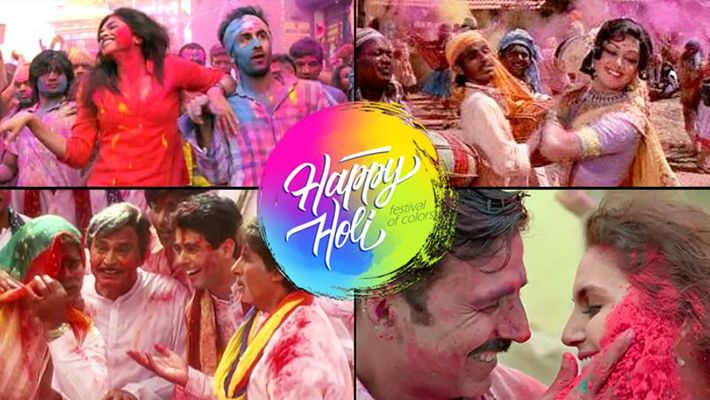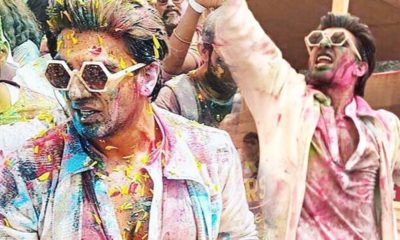Exclusive Premium Content
Holi No More Relevant In Our Films

The last time we saw a really memorable Holi song and dance on screen was in Ayan Mukerji’s Yeh Jawaani Hai Deewani. And Balam pichkari was back in 2013.
Since then the Ranbir-Deepika starrer’s producer Karan Johar has been pining to put the colour back into his films.
But the Holi situation just doesn’t show up in the scripts that he produces.
There was a time when Holi provided not only an occasion for outstanding song situations in Bollywood films but also a cue for great drama. Today, the festival of colours seems to have lost its knack of producing great song situations or drama.
In the past Holi was always a special occasion in our movies. It frequently occurred with a solid dramatic motivation. It could signify tragedy or joy . But Holi was always a reason for the plot to peer dramatically into a turning point in any film.Nowadays Holi songs and films revolving around the festival are as passe as Sharmila Tagore’s bouffant and Sadhana’s fringe cut.
There was a time when Holi provided not only an occasion for outstanding song situations but also a pretext for great drama. In the early 1970s, Mala Sinha got pregnant in Holi Aaee Re while playing Holi. By the 1980s Holi was a time of stress and hooliganism, both in and out of the movies. In Rajkumar Santoshi’s Damini, the employer’s drunken son rapes the maid of the house on Holi. Ouch.
Move forward to the new millennium and we see the Holi song becoming almost defunct. In Vipul Shah’s Waqt in 2005, the lead pair Priyanka Chopra and Akshay Kumar played Holi while she was pregnant. The pair got a real dressing down from papa Amitabh Bachchan.
One of Hindi cinema’s most memorable Holi sequences is to be found in this Shakti Samanta’s Kati Patang.The heroine , a widow played by Asha Parekh stands apart from the Holi revelers led by Rajesh Khanna who sings Aaj na chodenge bass humjoli khelenge hum holi while the lady in white sings back in subdued sorrowful regret about not being part of the celebration. Suddenly at the end of the song Khanna puts colour all over the widow’s hair, a daring defiant act that implies he has proposed marriage to the widow. The colours of Holi are used here to signify social reform.
In Ramesh Sippy’s Sholay the song-and-dance Holi ke din dil khil jaate hain(incidentally it is one of R D Burman’s career’s most badly recorded compositions) is rightly celebrated for exuding an ominous energy as the gaon wale celebrate Holi unheedful of the attack Gabbar Singh and the men are planning on them. But there is a much more evocative Holi sequence in Sholay where Jaya Bhaduri’s character, a widow in spotless white, is seen in a flashback swathed in the bright colours of Holi. The contrast is chilling.
In Vipul Shah’s Waqt there was a Holi sequence where Priyanka Chopra’s character announces she’s pregnant and then plays wild Holi with her husband Akshay Kumar. This has to be the most foolhardy glamour couple in the history of our cinema. Or maybe they just enjoy the thought of Holi too much to care about the wife’s delicate condition.
If Holi is fun in film it’s also an occasion for hectic hooliganism. The dark side of Holi was revealed in Yash Chopra’s Darr where Shah Rukh Khan with his face smeared with colours to avoid recognition gate-crashes into Juhi Chawla’s Holi bash and misbehaves with her. This has got to be the scariest Holi sequence in our cinema.
Rajinder Singh Bedi’s Phagun was based on a mishap that happens during Holi. Waheeda Rehman playing a rich businessman’s daughter, dances in ecstatic splendor on Holi to the song Piya sangg khelun holi when her economically humble husband Dharmendra sprays her with colour.She first responds with coy delight. When she sees her father frowning disapprovingly she berates her husband, ‘If you can’t buy me an expensive saree what right do you have to soil it?’ On Holi the wife loses her husband forever . This was the most tragic Holi sequence seen in Indian cinema.
Ho(o)liganism at the most shocking level of debasement was seen in Raj Kumar Santoshi’s Damini where the family maid is raped by the scion of the family and his friends who are high on bhang and low on morals. The gruesome rape was shot with remarkable intensity. Santoshi intercut the scenes of Holi revelery—the colours, the boisterousness, music and dance—with shots of the young girl being ravaged.Enough to put you off Holi for the rest of your life.
When its comes to using the swirl of Holi colours in a torrent of passion and romance, Sanjay Leela Bhansali is next to none. Colours have always been important to the cinema of Sanjay Leela Bhansali. In Goliyon Ki Raas Leela Ram Leela , a Gujju take on Shakespeare(Sex Peer in Gujarati?) Deepika and Ranveer meet during Holi.The way Bhansali encircles the lead pair Ranveer Singh and Deepika Padukone in a smorgasbord of colours makes Holi the most erotic festival seen on screen.Colours have always fascinated Bhansali. He waited for years before dooinga Holi sequence. To him it was like denying himself a favourite dessert until he earned it.
Director Sanjay Leela Bhansali says: “I loved the sounds of those Holi songs. I loved Holi aae re kanhaiayee from Mother India and Mohe panghat pe nandlal in Mughal-e-Azam. When I made Devdas, I so badly wanted to include a Holi song. But I couldn’t. But if you see, I’ve used the colours of Holi and the abeer and gulaal motifs throughout. I finally got to do a full-fledged Holi song in Ram Leela and I was delirious drenching my frames in passionate colours. “
Many conservatives feel Holi in cinema is no more than a pretext to drench women for titillation. However Shabana Azmi thinks imputing Holi with lasciviousness is too harsh. “Drenching both men and women has been a tradition over centuries. There is abandon and gaiety associated with Holi.It’s all done for fun. And very infectious. Morey Kanha Jo Aaye Palatke from Shyam Benegal’s Sardari Begum, written by my husband Javed Akhtar, is my favourite. The lines: ‘Unke peeche main chupke sa jaake/Yeh gulaal apne tan pe lagaake/Rang doongi unhein main lipatke…’ are very saucy, sensual and show the woman as an active participant and not a passive recipient of pleasure.”


